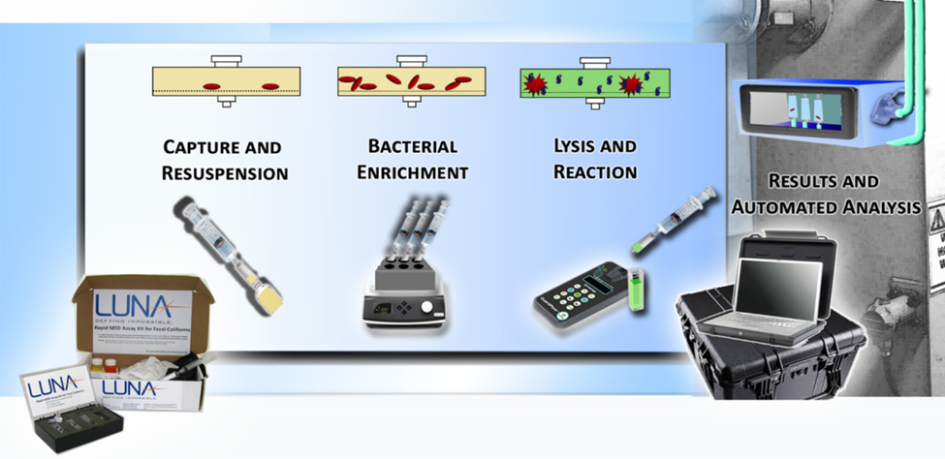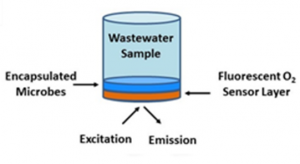Luna’s Assay Tests Water Quality Four Times Faster than Existing Methods
Christopher Tison, PhD, Senior Research Scientist and Biomedical Technologies Team Lead
Nathaniel Talley, Associate Scientist
Biomedical Technologies Group
Detection of E. coli is Inefficient and Costly
The presence of Escherichia coli (E. coli) is one of the more critical indicators of water quality and is used as a direct indicator of fecal contamination. However, existing detection methods are costly, time-consuming, require laboratory expertise, and take up to 48 hours to complete. Additionally, many existing techniques to detect E. coli are unable to distinguish between viable (live) and dead or stressed bacteria, a critical test requirement following disinfection in common water treatment processes such as UV irradiation. Luna is therefore developing a small, portable, rapid and easy to use assay system known as “E.coREADi™” to detect viable fecal coliforms in treated wastewater discharge or other water samples. Luna’s solution is based on a streamlined luminescent detection method in a self-contained syringe and filter device.

Luna is Enabling Detection of E. coli with Unique Assay Design
Luna’s fecal coliform detection platform is based upon a unique filter-based reaction chamber that allows all steps of the assay to be performed in a contained and simple fashion. The feasibility of this filter-based approach has been established using both simulated and actual wastewater, and the “all-in-one” format has been developed to allow future automation. Luna’s platform is scalable across samples volumes from 10 mL to 10 L, is specific to E. coli in the presence of non-fecal coliforms, and has been demonstrated to be effective in detection of chlorine and nutrient stress organisms.
Luna has currently demonstrated that a 5 hour total assay time is sufficient for detection of approximately 3 individual E. coli bacteria in a 100 mL sample. This is approximately 13 to 19 hours faster than the most advanced existing assays, and requires less than 15 minutes hands-on time, which is comparable to the existing standards. The E.coREADi™ assay is currently in transition from a laboratory assay to an easy-to-use, low-cost, and quantitative disposable assay kit.

The Future of Wastewater Analysis

In addition to the detection of E. coli, Luna is also developing state-of-the-art sensors for the detection of other critical wastewater quality metrics such as biological oxygen demand, or BOD. The BOD is an indicator of the total organic concentration in a water sample as represented by the oxygen required for biological organisms to break that organic matter down.
Luna is aiming to revolutionize BOD analysis by developing a disposable, automated, and microfluidic cartridge based biosensor to provide near-real-time analysis of a water sample’s total organic matter in laboratory or field settings. Luna’s technology integrates microbes encapsulated in a biocompatible matrix imparting long-term and room temperature preservation of viability, and an oxygen-sensitive earth metal embedded fluorescent thin film. Because microbial metabolism is proportional to the available nutrient source, oxygen depletion in the sample water can be directly correlated to the organic content. The current standard assay, BOD5, takes five days to complete and requires substantial laboratory space, equipment, and highly trained personnel for testing. To date, Luna has developed benchtop biosensors with microbes stable after storage at ambient temperatures for up to 6 months, and can accurately monitor the BOD of effluent from a local water treatment facility in less than 30 minutes!

Monitoring water quality is critical for municipal water treatment facilities, environmental testing agencies, and related industries in the civilian and military markets. Driven by increasing environmental regulation and industrial demands, the global water industry is a hundreds of billions dollar market. Similarly, “monitoring, control, and analytics” of wastewater treatment comprised approximately 3.0 of the 220 billion dollars in annual capital and operating expenditures for the municipal wastewater industry in 2014.
Join us this May at the Gaylord National Resort & Convention Center in National Harbor, MD where we will be presenting our water analysis development efforts at the Navy Forum for SBIR Transition (FST). Our Presentation will be in the Maryland 3 conference room at 11:50 am EST on Monday May 16, 2016. You can also find us at Booth #54. Come hear about our sensors and discuss this exciting technology with us!